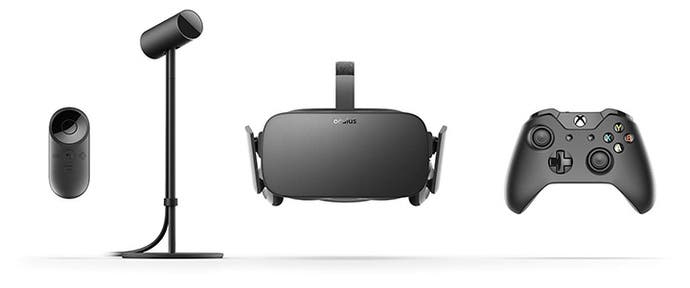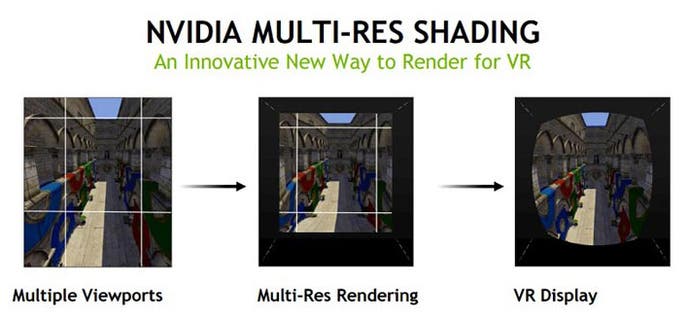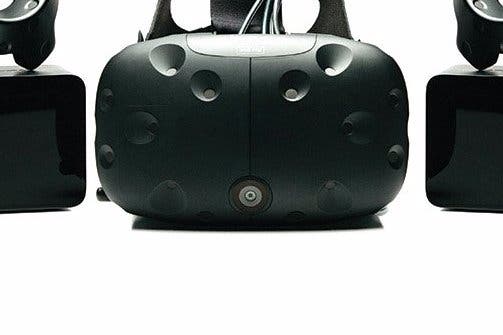Is your PC really VR-ready?
Digital Foundry talks recommended specs with VR developers.
As the days pass, we draw closer to a potentially seismic change in the PC gaming space - the arrival of Virtual Reality experiences, brought to life via the Oculus Rift and HTC's Vive. And for many, one key question needs to be comprehensively addressed - whether their existing gaming PCs can handle the strenuous requirements of the VR experience. And if they don't, what hardware will need an upgrade.
There's a sense that there's a lot of conflicting information out there. First up, let's take a look at the Oculus minimum spec:
- Nvidia GeForce GTX 970/AMD Radeon R9 290 equivalent or greater
- Intel Core i5 4590 equivalent or greater
- 8GB+ RAM
- 2x USB 3.0 port
- HDMI 1.3 video output supporting a 297MHz clock via a direct output architecture
- Windows 7 OS or greater
Some say that less than one per cent of the gaming PCs out there can meet this specification, but it's certainly a good place to start from Oculus, certainly bearing in mind the GPU spec. Take a look at Steam's hardware survey - probably our best look into the hardware being used by core gamers - and the GTX 970 absolutely dominates. Indeed, there have been some months where that specific GPU has accounted for over five per cent of all Steam users. Only Nvidia's older GTX 760 gets close.
"The recommended spec will stay constant over the lifetime of the Rift," says Oculus. "As the equivalent-performance hardware becomes less expensive, more users will have systems capable of the full Rift experience. Developers, in turn, can rely on Rift users having these modern machines, allowing them to optimise their game for a known target, simplifying development."
There's just one problem. To run the same game at full-spec VR, we are looking at a colossal increase in pixel-throughput. As Nvidia's general manager of Shield, gaming and VR business, Jason Paul explained in a VentureBeat interview:
"If you look at your typical PC gaming experience, 90 per cent of the gamers out there play at 1080p. For a smooth experience you don't want to go below 30fps. Compare that to VR where the displays are about 2K, but you have to render closer to 3K, and you don't want to go below 90fps. It's about a sevenfold increase in raw performance to render for VR versus traditional PC gaming. You have to do that in less than 20 milliseconds from head rotation to what shows up on your display."

The GTX 970 is so popular because it occupies a unique sweet spot for 1080p gamers, but question marks obviously surround its ability to create a good VR experience when both frame-rate and pixel density increase to such an enormous extent. And this is perhaps borne out by the fact that every major VR demo we've personally experienced has played out on more capable hardware - GTX 980 for the Vive SteamVR suite of demos and GTX 980 Ti/Titan X for Crytek's Return to Dinosaur Island and WETA's remarkable Hobbit demo.
And then there's the fact that the first major game to ship with full Vive support also demands a GTX 980. On the face of it, the evidence suggests that Oculus' attempt to set a recommended spec has already failed.
Iestyn Lloyd of Lloyd Digital has created several VR demos and installations and wrote the VR Learn documentation for the enormously popular Unity engine. We asked him whether the Oculus minimum spec can actually cut it.
"Yes, the minimum specs for VR are a bit of an interesting one," he says. "I'm currently developing for Vive on a i7-4790K and a GTX 780 Ti, and it seems to run most demos pretty well. This is - if I recall correctly - roughly equivalent to a GTX 970."
Lloyd makes an interesting point - VR 'ports' may be limited to certain suitable titles and using existing non-VR games as a comparison point in terms of setting a recommended spec may not be the best way to view the situation. To get the best out of the platform, we need to see games built from the ground up, and it makes sense to design them around existing, widely available hardware like the GTX 970 and R9 290.
"Due to the VR user experience considerations, I am unsure how many AAA games will simply add on VR support," he says. "To make a good VR game that doesn't make people nauseous, you really need to consider it from the very start of development, if not earlier in the planning stage. There are some exceptions, such as Elite Dangerous - cockpit-based games generally translate well into VR."
It's important to stress that GTX 970 and R9 290 were outlined as a minimum spec though, and as is always the case in the PC space, faster GPU hardware can obviously produce better results. Nvidia and AMD are also looking to dual-chip GPU set-ups to provide a required boost to performance, the basic principle being that each GPU handles the perspective of 'one eye', with parallel rendering for minimal latency. But right now at least, such technologies are still in their formative stages.

"Right now, SLI doesn't really help," Lloyd says. "Although I expect this will change in the near future with a combination of newer graphics APIs such as DX12/Vulkan/Liquid VR/VR Direct, new graphics cards and game engines (Unity/UE4) supporting it... I had some good experiences earlier this year when developing a VR installation piece with a 980 Ti as the target hardware - I was able to supersample, along with turning on a lot more visual effects and using more complex shaders to make things really shine."
So if GTX 970 and R9 290 are the base level, will there be titles that move beyond this tier of hardware. Frontier's announcement of a GTX 980 minimum spec is clearly a cause for concern. Our question was pretty straightforward - to what extent is there 'wiggle room'? After all, a factory-overclocked GTX 970 can move close to GTX 980 performance - and in some cases, an OC pushed to its limits can actually see the cheaper card nose ahead.
"The GTX 980 is still our recommended spec for running Elite Dangerous in Vive at a full 90fps with our VR optimised graphics settings. It's what we all agree will get you the most consistent and comfortable gameplay, even in cases where the GPU will be under greater load," Elite Dangerous Executive Producer Michael Brookes tells us, before going on to say that the game actually super-samples for the best possible presentation.
"The human brain has a low tolerance to hiccups in the VR space, and that's the spec we're confident putting our name on for a consistent gameplay experience when you're exploring our galaxy. Our spec also takes into account that we're not rendering at Vive's native resolution of 2160x1200 but at 3024x1680 (1.4x each dimension recommended by Valve) and then scaling down. We believe this is hugely important for anti-aliasing in VR to avoid noticing pixels so much, as other solutions can leave them appearing relatively large at the centre of your vision."
Frontier has defined minimum spec according to the experience it wants to deliver, but nothing will stop you trying out less capable hardware. But the point is that VR has another key requirement that is less important in traditional PC gaming - minimum frame-rate really shouldn't drop below the target 90fps.
"Again, it's about a better experience in an environment where you're especially sensitive to anything that breaks the reality of the world," says Brookes. "With that said, we've had a number of reports from our community saying they've achieved comfortable results with a lower spec. They've embraced VR since we supported the first Oculus Rift development kits in 2013, and they're really testing the limits of the experience. We don't want to recommend a lower spec ourselves, but some players may find they're still comfortable even with a lower spec GPU than the 980 we suggest."

While most of the focus has been on the graphics card, we shouldn't forget the importance of the CPU in forging a great VR experience. It all comes back to that 90fps target frame-rate. Consider the role of the CPU - it's not just about processing the game logic, it also prepares all of the draw calls for the graphics card. Assuming you usually game at 60fps, basic maths suggests that CPU utilisation will increase substantially to service a higher frame-rate. And in our experience, there's no linear scaling in terms of CPU speed vs in-game frame-rate. Even our in-house eight-core/16-thread monster - the Core i7 5960X, overclocked to 4.4GHz no less - can struggle reaching 90fps minimum frame-rates.
"Our VR CPU spec matches our recommended spec for running the game outside of VR (see Core System Requirements Here too, our community reports quality experiences with more modest CPUs, and our own minimum spec requires only a general quad-core CPU at 2GHz," says Frontier's Michael Brookes.
"That said, we want a near flawless VR experience and running the physics and simulation components at 90fps puts even greater load on the CPU, so the Core i7 3770 is what we're happy to put our name to for consistent, high-quality gameplay in VR."
What's clear is that there's going to be a lot of room to manoeuvre in terms of VR specs, based not just on developer requirements, but also in terms of user comfort. Brookes admits that this will change on a user-to-user basis.
"System specs are always a question for PC gaming, and it's made more complicated by VR," he confirms. "We've been working with VR since the hardware was available, and we've found what is and isn't comfortable varies from player to player. That makes picking a 'minimum' spec for virtual reality more challenging. We're recommending the spec we feel will offer an experience matching our standards. We're optimising and adding to Elite Dangerous all the time, so there's always a degree of 'wiggle room,' even on our rigs."

